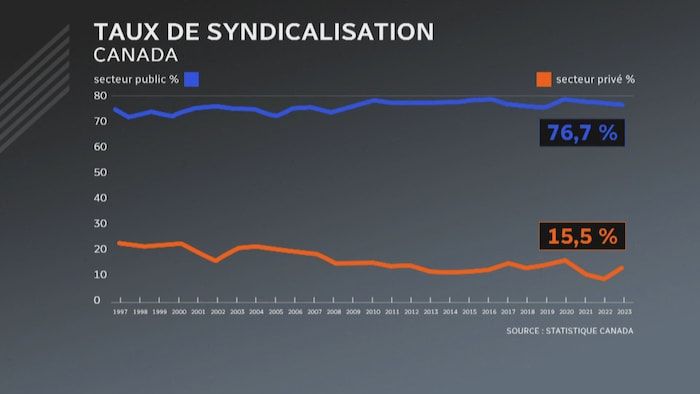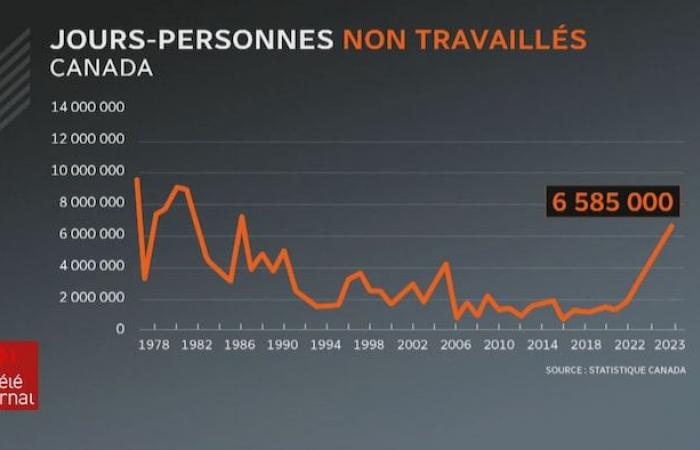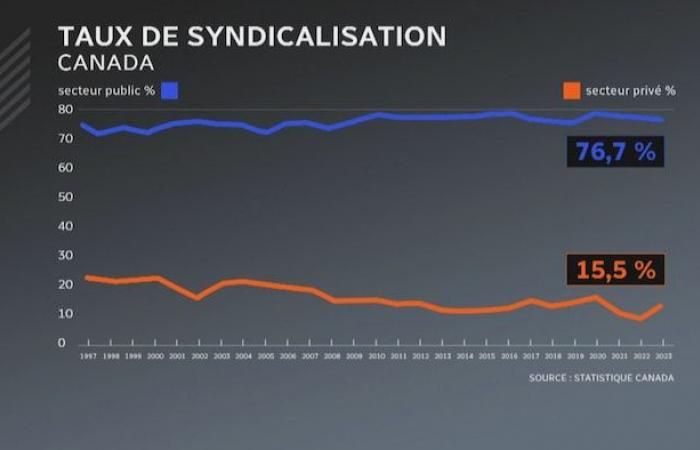Quebec civil service, SAQ, longshoremen at the port of Montreal, and now Canada Post… Strikes have experienced a meteoric rise in Quebec and Canada for two years, in a movement propelled by the increase in the cost of living.
In 2023, Canada recorded nearly 6.6 million person days (the number of days multiplied by the number of people) not worked due to labor conflicts, the highest since 1986, according to Statistics Canada.
Open in full screen mode
The number of person days not worked due to labor conflicts has been increasing in recent years.
Photo : -
This upward trend is explained by a low unemployment rate and above all an extraordinary rise in inflation
is the opinion of Claudette Carbonneau, former president of the CSN.
Same story for industrial relations professor at the University of Quebec at Trois-Rivières Jean-Claude Bernatchez. Trade unionism is in a catch-up strategy […] purchasing power
he summarizes.
The scarcity of labor – accentuated by the departure of baby boomers from the labor market – provides significant leverage for negotiation, according to Mr. Bernatchez.
To this factor is added a change of values
within the young workforce, which wants to ensure a good balance between work and personal life, adds the professor. Young people no longer think like boomers thought. They no longer work like crazy. They want to work less, but work better
he explains.
Teleworking and artificial intelligence are also elements that contribute to a changing world of work, notes Mr. Bernatchez.
By the same token, the increase in strikes is perhaps not about to run out of steam, he suggests.
I predict that the trend we are observing will be established for probably 5 to 10 years. […] It’s a change in values, a generational movement, it’s a revolution that we are currently witnessing.
The strike, a profitable pressure tool
The Common Front, which represented nearly 420,000 Quebec public service workers during negotiations in the fall of 2023, obtained a 17.4% salary increase in 4 years, almost double what was initially proposed. ’employer.
Open in full screen mode
Thousands of members of the Union Common Front participate in a demonstration in front of the Parliament building, in Quebec, in November 2023.
Photo: - / Colin Côté-Paulette
These impressive gains may have inspired other union movements, believes Claudette Carbonneau. We realize that it is only through collective action that we achieve [à des gains]. And on that side, yes, it restores the nobility of union action.
A strong public sector union movement
According to Statistics Canada, the unionization rate in the public sector has been climbing for 25 years, and stood at 76.7% in 2023, while it has declined in the private sector, reaching 15.5%.

Open in full screen mode
In Canada, the public sector unionization rate has been climbing for 25 years.
Photo : -
Furthermore, public sector employees have walked off the job more in 2023: on average, 54 hours of work were lost per 1,000 public sector employees, compared to just over 9 hours in the private sector.
Women – more numerous in the public sector – also spent more time on strike than men last year, a trend that is the opposite of the last 50 years.
With information from Jean-Philippe Hughes








